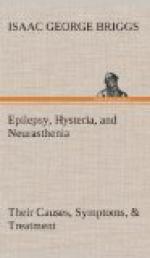The chemically-changed chyme is now termed Chyle, and is ready to be absorbed by the minute, projecting Villi.
The fatty portion of the chyle is absorbed by minute capillaries and ultimately mingles with the blood, which may look quite milky after a fatty meal.
The remaining food is absorbed by the blood capillaries in the villi, and passes to the liver for filtration and storage.
The large bowel has Lieberkuehn’s glands, but not villi, and is relatively unimportant, though most of the water the body needs is absorbed from here.
How food becomes energy and tissue we do not know. The tissues are continually being built up from assimilated food, and as constantly being burnt away, oxygen for this purpose being extracted from the air we inhale, and carried via the blood to every corner of the body. The ashes of this burning are expelled into the blood and lymph, and carried out of the body by the kidneys, lungs, skin and bowels. The product of the burning is the marvel—Life; the extinction of the fire is the terror—Death.
Energy is obtained almost solely from the combustion of fats and sugars, proteids being reconverted into albumin, and then broken down to obtain their carbon for combustion, the nitrogen being expelled, but proteids are essential for the building of the tissues themselves, the stones of the furnaces which burn up carbohydrates and fats.
The time taken in the digestion of foods was first studied through a wound in the stomach of St. Martin, a Canadian. Experiments were made with various well-masticated foods, and with similar foods placed unchewed, into the stomach through the wound, the latter experiment being carried out by millions of people at every meal, by a slightly different route.
Boiled food is more easily digested than fried or roasted (the frying pan should be anathema to a neuropath); lean meat than fat; fresh than salt; hot meat than cold; full-grown than young animals, though the latter are more tender; white flesh than red; while lean meat is made less, and fat meat more digestible, by salting or broiling. Oily dishes, hashes, stews, pastries and sweetmeats are hard to digest. Bread should be stale, and toasted crisply right through. The time, compared with the thoroughness of digestion, is of little importance, as it varies widely within physiologic bounds.
Most people fancy that the more they eat the stronger they become, whereas the digestion of all food beyond that actually needed to repair the waste due to physical and mental effort consumes priceless nerve energy, and weakens one. The greater part of excessive food has literally to be burnt away by the body, which causes great strain, mainly on the muscles. The question is not: “How much can I eat?” but: “How much do I need?”
* * * * *




